Using Satellite Data to Optimize Wheat Yield and Quality under Climate Change
Abstract
:1. Introduction
2. Materials and Methods
- A table of GDD required to reach the heading stage from the emergence stage for each cultivar. This is described in Section 2.1.
- To calculate GDD for each field. This is described in Section 2.2.
- To disseminate the algorithm as a tool to all stakeholders (farmers and the scientific community). This is described in Section 2.3.
2.1. Wheat Fields
- The Gilat-CAL dataset contains data from 76 wheat variety test experiments from ten growth seasons (2008–2017) at Gilat Research Center. Each experiment included several spring bread wheat cultivars spanning the phenological range of Israeli elite germplasm. Each experiment typically included 8–15 cultivars, with a total of 22 different cultivars. The dataset comprises more than 1500 heading date records, taken by one person (DJ. Bonfil). Daily meteorological data from Gilat meteorological station was used. The meteorological station was typically within 1 km distance from the field, with a maximum distance of 2.5 km. This data set was used to calculate the GDD (with a temperature threshold of 0 °C) and the number of days from emergence to heading (E–H) for each cultivar.
- The Saad-VAL dataset contains data from commercial wheat fields at Saad (Saad, Saad-BH, Figure 1) from four growth seasons (2017–2020). Four cultivars (Amit, Gadish, Kitain and Ruta) represent most of the fields (180 out of 206 records). A single person (Y. Nir, the farmer) reported all heading data in the Saad-VAL dataset.
- The CVexp-VAL dataset contains data from 28 wheat variety test experiments established across Israel from four growth seasons (2017–2020). The fields are located in the northern and southern growing Israeli areas (Figure 1). The dataset includes 188 records from 19 cultivars. Eleven cultivars represent 163 out of 188 fields. In this dataset, heading data for each experiment were taken by the local extension person that runs the experiment.
2.2. Satellite and Numerical Weather Prediction Model Data
2.3. Google Earth Engine (GEE)
3. Results
4. Discussion
5. Conclusions
Supplementary Materials
Author Contributions
Funding
Acknowledgments
Conflicts of Interest
References
- Mutanga, O.; Dube, T.; Galal, O. Remote Sensing of Crop Health for Food Security in Africa: Potentials and Constraints. Remote Sens. Appl. Soc. Environ. 2017, 8, 231–239. [Google Scholar] [CrossRef]
- Shewry, P.R.; Hey, S.J. The Contribution of Wheat to Human Diet and Health. Food Energy Secur. 2015, 4, 178–202. [Google Scholar] [CrossRef] [PubMed]
- Distelfeld, A.; Li, C.; Dubcovsky, J. Regulation of Flowering in Temperate Cereals. Curr. Opin. Plant Biol. 2009, 12, 178–184. [Google Scholar] [CrossRef] [PubMed] [Green Version]
- Bonfil, D.J.; Abbo, S.; Svoray, T. Sowing Date and Wheat Quality as Determined by Gluten Index. Crop Sci. 2015, 55, 2294–2306. [Google Scholar] [CrossRef]
- Har-Gil, D.; Bonfil, D.J.; Svoray, T. Multi Scale Analysis of the Factors Influencing Wheat Quality as Determined by Gluten Index. Field Crops Res. 2011, 123, 1–9. [Google Scholar] [CrossRef]
- Moldestad, A.; Fergestad, E.M.; Hoel, B.; Skjelvåg, A.O.; Uhlen, A.K. Effect of Temperature Variation during Grain Filling on Wheat Gluten Resistance. J. Cereal Sci. 2011, 53, 347–354. [Google Scholar] [CrossRef]
- Miller, O.; Helman, D.; Svoray, T.; Morin, E.; Bonfil, D.J. Explicit Wheat Production Model Adjusted for Semi-Arid Environments. Field Crops Res. 2019, 231, 93–104. [Google Scholar] [CrossRef]
- Rosenzweig, C.; Elliott, J.; Deryng, D.; Ruane, A.C.; Müller, C.; Arneth, A.; Boote, K.J.; Folberth, C.; Glotter, M.; Khabarov, N.; et al. Assessing Agricultural Risks of Climate Change in the 21st Century in a Global Gridded Crop Model Intercomparison. Proc. Natl. Acad. Sci. USA 2014, 111, 3268–3273. [Google Scholar] [CrossRef] [Green Version]
- Schauberger, B.; Gornott, C.; Wechsung, F. Global Evaluation of a Semiempirical Model for Yield Anomalies and Application to Within-Season Yield Forecasting. Glob. Chang. Biol. 2017, 23, 4750–4764. [Google Scholar] [CrossRef]
- Xu, C.; Liu, H.; Williams, A.P.; Yin, Y.; Wu, X. Trends toward an Earlier Peak of the Growing Season in Northern Hemisphere Mid-Latitudes. Glob. Chang. Biol. 2016, 22, 2852–2860. [Google Scholar] [CrossRef]
- Wan, Z.; Zhang, Y.; Zhang, Q.; Li, Z.-L. Quality Assessment and Validation of the MODIS Global Land Surface Temperature. Int. J. Remote Sens. 2004, 25, 261–274. [Google Scholar] [CrossRef]
- Lensky, I.M.; Dayan, U. Detection of Finescale Climatic Features from Satellites and Implications for Agricultural Planning. Bull. Am. Meteorol. Soc. 2011, 92, 1131–1136. [Google Scholar] [CrossRef] [Green Version]
- Jin, M.; Dickinson, R.E. Land Surface Skin Temperature Climatology: Benefitting from the Strengths of Satellite Observations. Environ. Res. Lett. 2010, 5, 044004. [Google Scholar] [CrossRef] [Green Version]
- Blum, M.; Lensky, I.M.; Nestel, D. Estimation of Olive Grove Canopy Temperature from MODIS Thermal Imagery Is More Accurate than Interpolation from Meteorological Stations. Agric. For. Meteorol. 2013, 176, 90–93. [Google Scholar] [CrossRef]
- Kloog, I.; Chudnovsky, A.; Koutrakis, P.; Schwartz, J. Temporal and Spatial Assessments of Minimum Air Temperature Using Satellite Surface Temperature Measurements in Massachusetts, USA. Sci. Total Environ. 2012, 432, 85–92. [Google Scholar] [CrossRef] [Green Version]
- Bonfil, D.J.; Mufradi, I.; Klitman, S.; Asido, S. Wheat Grain Yield and Soil Profile Water Distribution in a No-Till Arid Environment. Agron. J. 1999, 91, 368–373. [Google Scholar] [CrossRef]
- Kafkafi, U.; Bonfil, D.J. Integrated Nutrient Management—Experience and concepts from the Middle East. In Integrated Nutrient Management for Sustainable Crop Production and Environmental Safety; Milkha, S.A., Grant, C.A., Eds.; Haworth Press, Inc.: Binghamton, NY, USA, 2008; pp. 523–565. [Google Scholar]
- López-Bellido, L.; Fuentes, M.; Castillo, J.E.; López-Garrido, F.J. Effects of Tillage, Crop Rotation and Nitrogen Fertilization on Wheat-Grain Quality Grown under Rainfed Mediterranean Conditions. Field Crops Re. 1998, 57, 265–276. [Google Scholar] [CrossRef]
- Turner, N.C. Further Progress in Crop Water Relations. In Advances in Agronomy; Sparks, D.L., Ed.; Academic Press: Cambridge, MA, USA, 1996; Volume 58, pp. 293–338. [Google Scholar]
- Wallach, D.; Palosuo, T.; Thorburn, P.; Gourdain, E.; Asseng, S.; Basso, B.; Buis, S.; Crout, N.; Dibari, C.; Dumont, B.; et al. How Well Do Crop Modeling Groups Predict Wheat Phenology, given Calibration Data from the Target Population? Eur. J. Agron. 2021, 124, 126195. [Google Scholar] [CrossRef]
- Pimstein, A.; Eitel, J.U.H.; Long, D.S.; Mufradi, I.; Karnieli, A.; Bonfil, D.J. A Spectral Index to Monitor the Head-Emergence of Wheat in Semi-Arid Conditions. Field Crops Res. 2009, 111, 218–225. [Google Scholar] [CrossRef] [Green Version]
- Sadeghi-Tehran, P.; Sabermanesh, K.; Virlet, N.; Hawkesford, M.J. Automated Method to Determine Two Critical Growth Stages of Wheat: Heading and Flowering. Front. Plant Sci. 2017, 8, 8. [Google Scholar] [CrossRef] [Green Version]
- Justice, C.O.; Townshend, J.R.G.; Vermote, E.F.; Masuoka, E.; Wolfe, R.E.; Saleous, N.; Roy, D.P.; Morisette, J.T. An Overview of MODIS Land Data Processing and Product Status. Remote Sens. Environ. 2002, 83, 3–15. [Google Scholar] [CrossRef]
- Saha, S.; Moorthi, S.; Wu, X.; Wang, S.; Nadiga, S.; Tripp, P.; Behringer, D.; Hou, Y.T.; Chuang, H.Y.; Iredell, M.; et al. Updated Daily. NCEP Climate Forecast System Version 2 (CFSv2) 6-Hourly Products. Available online: https://doi.org/10.5065/D61C1TXF (accessed on 20 February 2020).
- Scharlemann, J.P.W.; Benz, D.; Hay, S.I.; Purse, B.V.; Tatem, A.J.; Wint, G.R.W.; Rogers, D.J. Global Data for Ecology and Epidemiology: A Novel Algorithm for Temporal Fourier Processing MODIS Data. PLoS ONE 2008, 3, e1408. [Google Scholar] [CrossRef] [PubMed]
- Shiff, S.; Helman, D.; Lensky, I.M. Worldwide Continuous Gap-Filled MODIS Land Surface Temperature Dataset. Sci. Data 2021, 8, 74. [Google Scholar] [CrossRef] [PubMed]
- Gorelick, N.; Hancher, M.; Dixon, M.; Ilyushchenko, S.; Thau, D.; Moore, R. Google Earth Engine: Planetary-Scale Geospatial Analysis for Everyone. Remote Sens. Environ. 2017, 202, 18–27. [Google Scholar] [CrossRef]
- Thrasher, B.; Maurer, E.P.; McKellar, C.; Duffy, P.B. Technical Note: Bias Correcting Climate Model Simulated Daily Temperature Extremes with Quantile Mapping. Hydrol. Earth Syst. Sci. 2012, 16, 3309–3314. [Google Scholar] [CrossRef] [Green Version]
- Taylor, K.E.; Stouffer, R.J.; Meehl, G.A. An Overview of CMIP5 and the Experiment Design. Bull. Am. Meteorol. Soc. 2012, 93, 485–498. [Google Scholar] [CrossRef] [Green Version]
- Good, E.J. An in Situ-Based Analysis of the Relationship between Land Surface “Skin” and Screen-Level Air Temperatures. J. Geophys. Res. Atmos. 2016, 121, 8801–8819. [Google Scholar] [CrossRef]
- Lensky, I.M.; Dayan, U.; Helman, D. Synoptic Circulation Impact on the Near-Surface Temperature Difference Outweighs That of the Seasonal Signal in the Eastern Mediterranean. J. Geophys. Res. Atmos. 2018, 123, 11333–11347. [Google Scholar] [CrossRef]
- Agam, N.; Kustas, W.P.; Anderson, M.C.; Li, F.; Neale, C.M.U. A Vegetation Index Based Technique for Spatial Sharpening of Thermal Imagery. Remote Sens. Environ. 2007, 107, 545–558. [Google Scholar] [CrossRef]
- Rotem-Mindali, O.; Michael, Y.; Helman, D.; Lensky, I.M. The Role of Local Land-Use on the Urban Heat Island Effect of Tel Aviv as Assessed from Satellite Remote Sensing. Appl. Geogr. 2015, 56, 145–153. [Google Scholar] [CrossRef]

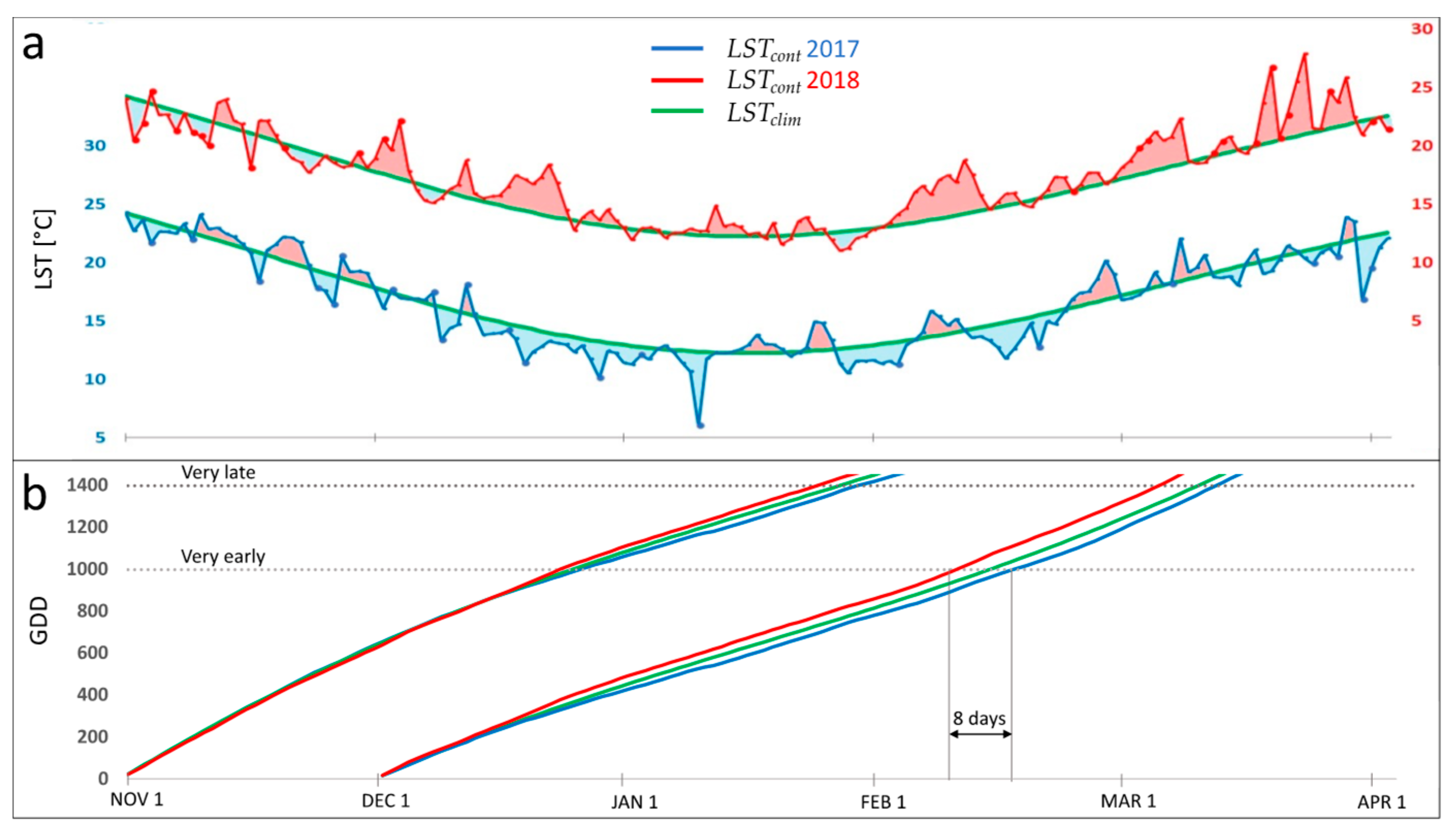


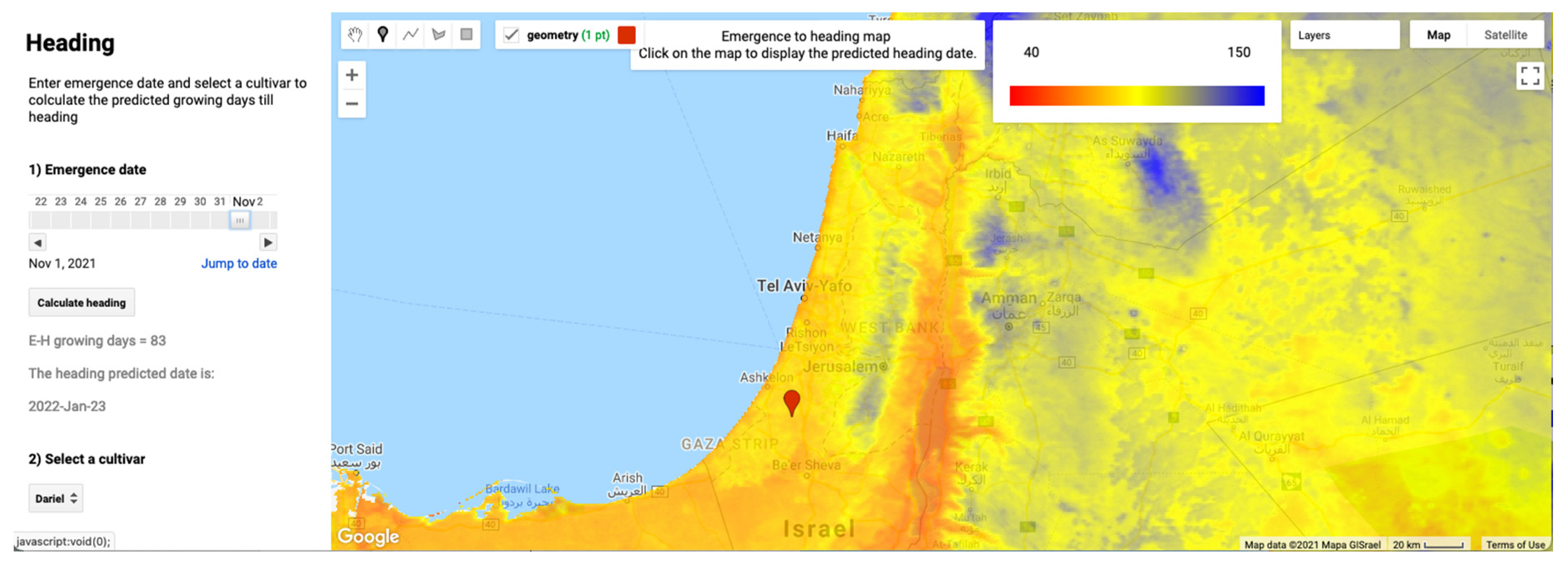
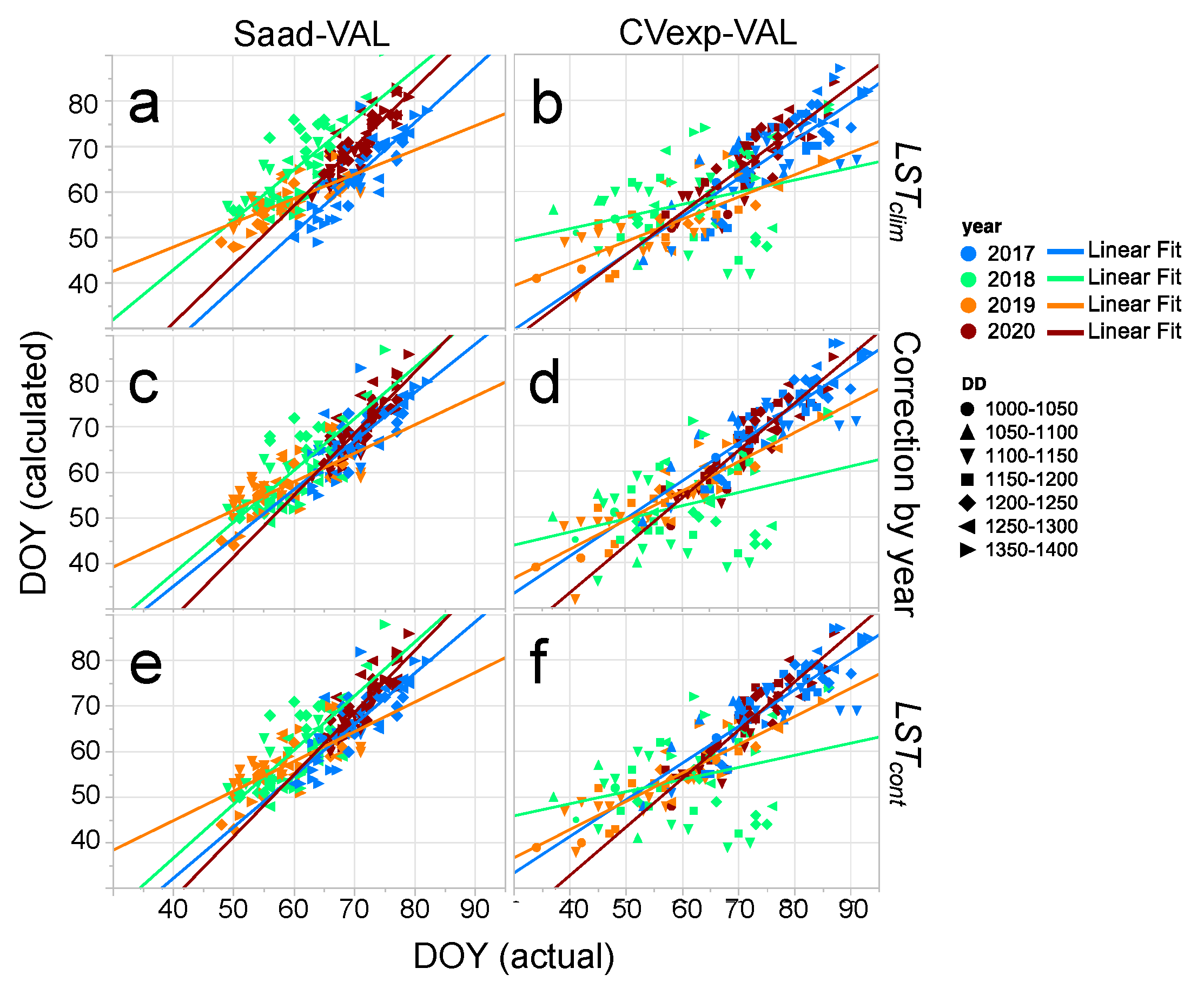
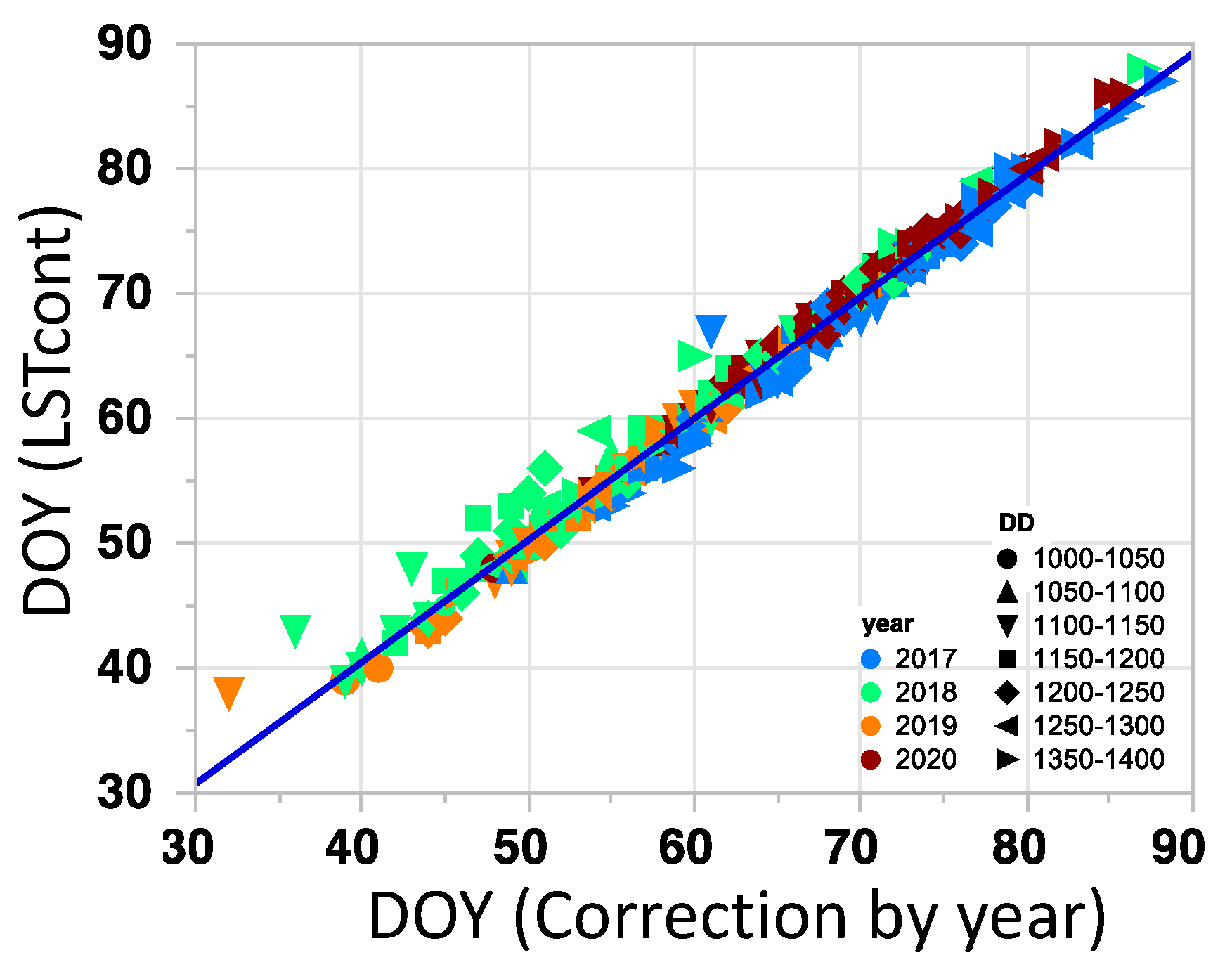
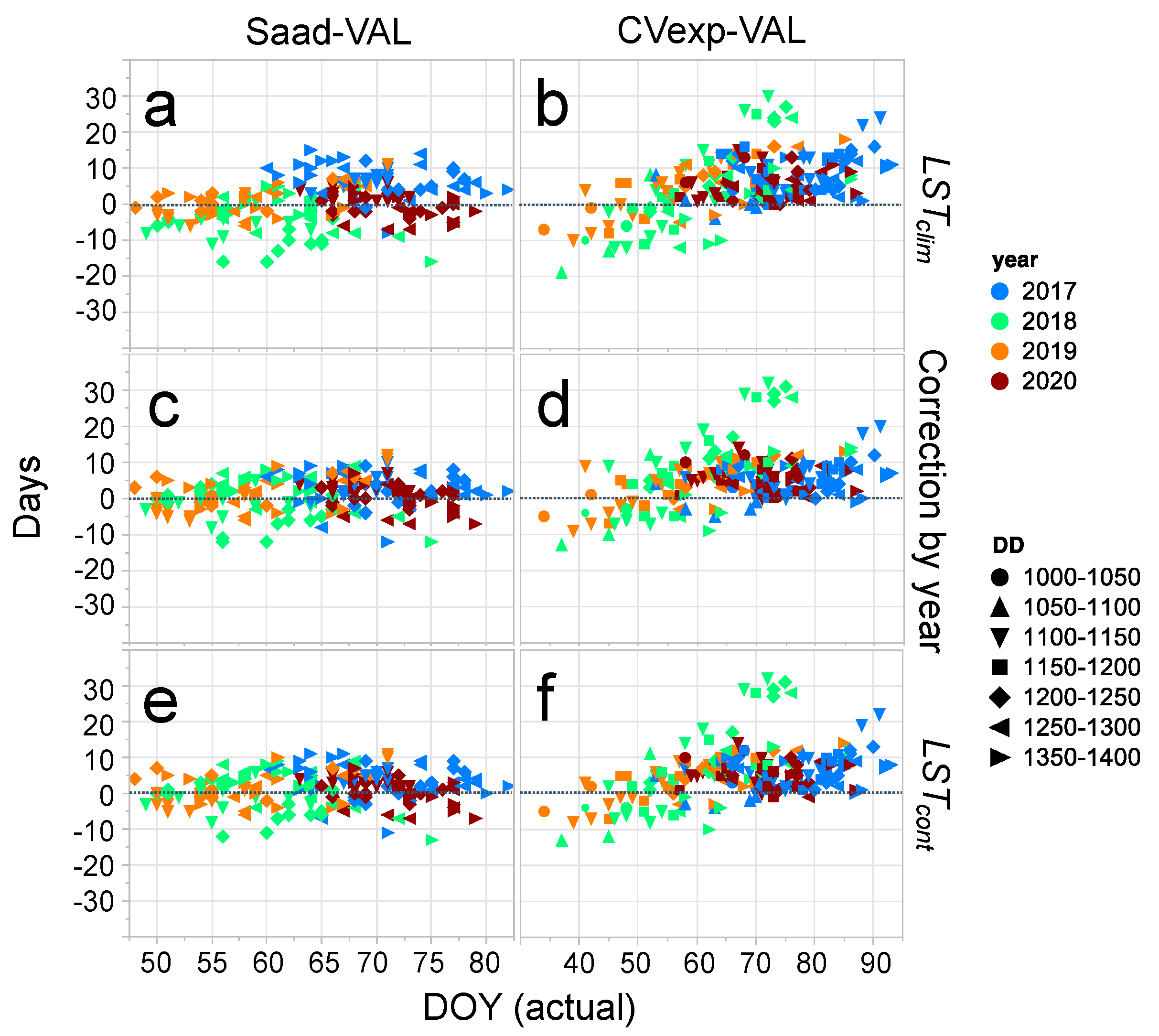
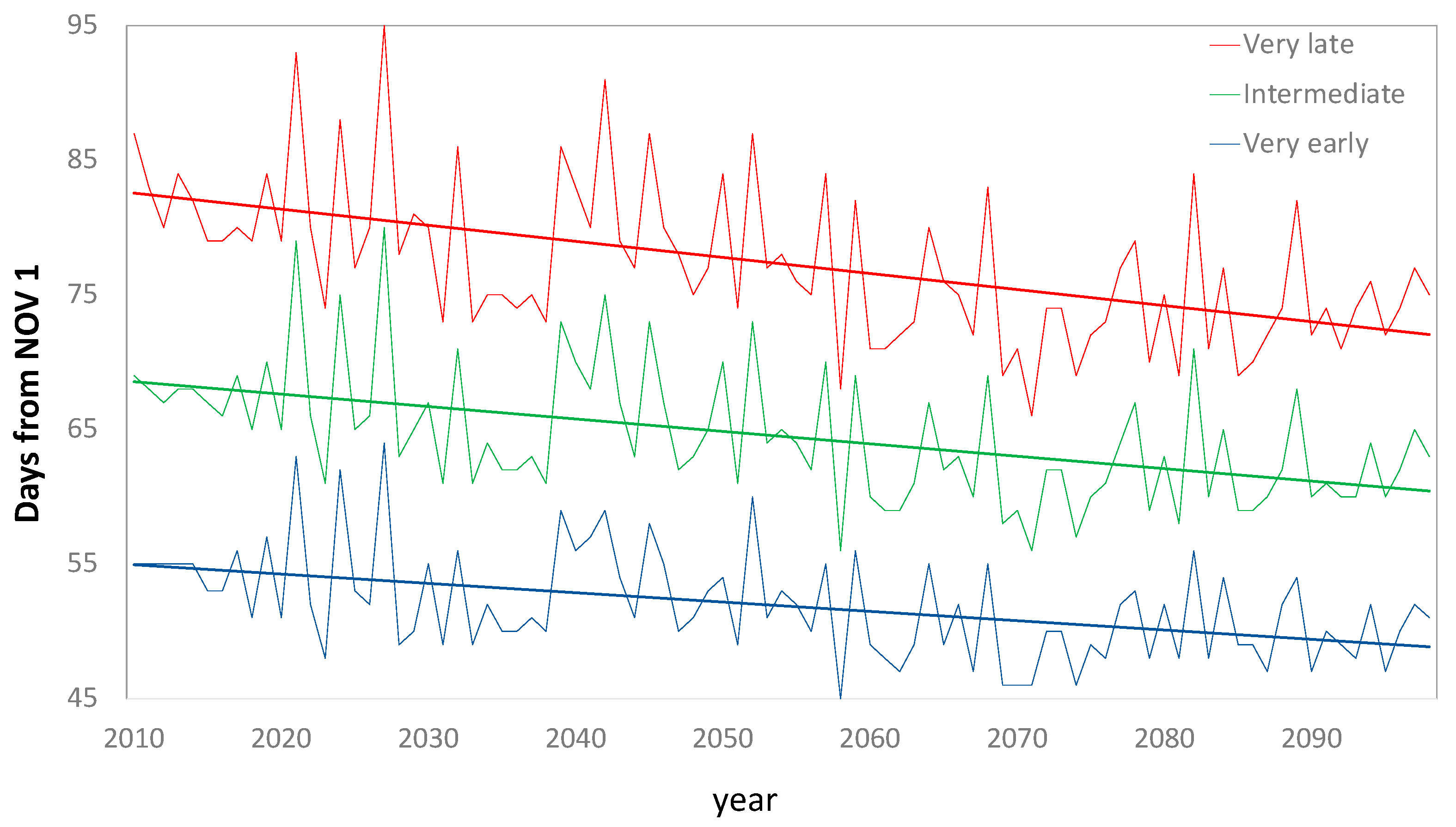
| Saad-VAL (n = 206) | CVexp-VAL (n = 188) | |||||
|---|---|---|---|---|---|---|
| LSTclim | Yearly Correction | LSTcont | LSTclim | Yearly Correction | LSTcont | |
| r | 0.727 | 0.850 | 0.844 | 0.773 | 0.826 | 0.820 |
| R2 | 0.529 | 0.723 | 0.712 | 0.598 | 0.682 | 0.673 |
| Bias | 15.172 | 4.182 | 3.562 | 17.891 | 9.017 | 11.438 |
| SEP | 5.785 | 4.594 | 4.745 | 6.790 | 6.786 | 6.638 |
Publisher’s Note: MDPI stays neutral with regard to jurisdictional claims in published maps and institutional affiliations. |
© 2021 by the authors. Licensee MDPI, Basel, Switzerland. This article is an open access article distributed under the terms and conditions of the Creative Commons Attribution (CC BY) license (https://creativecommons.org/licenses/by/4.0/).
Share and Cite
Shiff, S.; Lensky, I.M.; Bonfil, D.J. Using Satellite Data to Optimize Wheat Yield and Quality under Climate Change. Remote Sens. 2021, 13, 2049. https://doi.org/10.3390/rs13112049
Shiff S, Lensky IM, Bonfil DJ. Using Satellite Data to Optimize Wheat Yield and Quality under Climate Change. Remote Sensing. 2021; 13(11):2049. https://doi.org/10.3390/rs13112049
Chicago/Turabian StyleShiff, Shilo, Itamar M. Lensky, and David J. Bonfil. 2021. "Using Satellite Data to Optimize Wheat Yield and Quality under Climate Change" Remote Sensing 13, no. 11: 2049. https://doi.org/10.3390/rs13112049







